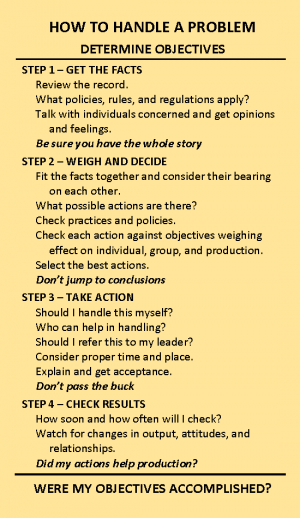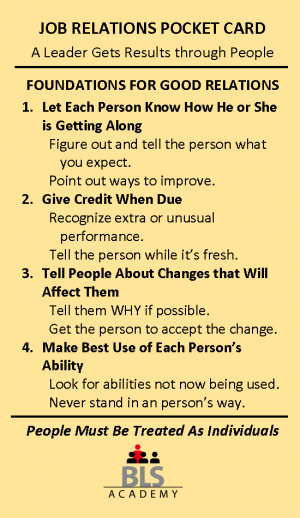
Job Relations - The Grease
That Makes Relations Smooth!
Job Relations is the TWI component that develops the skill of leading. Good leaders are able to get their jobs done by working with and through people. Some leaders may find this difficult if they are unwilling to delegate or take charge. Sometimes the people they lead have more knowledge of the work or more years of service. Other times, they have to deal with people who have never worked before, or who have worked in different work environments and are unfamiliar with their new organization’s rules or expectations. To be successful, the leader must figure out how to motivate people in all these types of situations. Leadership is getting people to do what needs to be done, when it needs to be done, and the way it needs to be done, because THEY want to. JR will develop that skill in your leaders.
There are three main components to the JR Program:
- 4-Step JR Method of Problem Solving – Used to solve people problems – defined as anything the leader has to take action on.
- Foundations for Good Relations – The actions a leader can take every day to prevent problems from occurring in the first place.
- Tips for Getting Opinions and Feelings – Techniques the leader can use to help get to the bottom of problems or issues.
Job Relations training teaches the leader how to handle his “people problems,” and more importantly, how to establish the conditions that prevent problems from occurring in the first place. When we speak of problems, a problem is anything on which the leader must to take action. Using a standard four-step method outlined on the JR Pocket Card, the leader first determines his objective – what does he want to achieve in this situation. He then follows the four-step method for handling a problem, a simple process that will lead to powerful results.
Many times senior leaders perceive the JR 4-step method as too simple. However, its simplicity is its strength. Being simple but effective leads to its greater use, especially with issues that seem minor, but that often turn into major problems if not addressed. In Step 1, gathering the facts, all the facts which includes opinions and feelings, the leader builds a strong foundation of understanding of the problem. This foundation then makes it possible in Step 2 to develop multiple courses of action, and then, weigh and decide on which ones to implement. In Step 3, the leader takes action and follows up in Step 4 by checking the results. The bottom line is did the leader achieve his objective. If not, he will need to cycle back through the four steps.
Careful review of the four steps will show a close similarity to the Plan-Do-Check-Act (PDCA) cycle, but in this case adapted to dealing with people problems. JR can help extend the problem solving process to your human systems or you can start with JR and solving problems with people, and then, adapt it to solving quality, machine and materials problems.
On the flip side of the JR Pocket Card are the Foundations for Good Relations. The foundations will help prevent problems from occurring in the first place. Letting each employee know how they are doing is critical to the employee’s success and as well as the operation’s. Providing expectations and telling them ways to improve will help them do their jobs as they continue to learn and grow. Giving credit when due, recognizing in a timely manner that extra effort someone has provided, or the fact that day in and day out they perform their job without complaint, helps build the person’s morale and that of the whole team. A key foundation is letting people know about changes before they are implemented. And telling what is going to happen is not enough; try to tell them why the change is necessary and get the person to accept the change. The last foundation is making best use of the person’s abilities. Everyone wants to contribute. Many people have skills they use daily outside the workplace that can significantly help the operation, if the leader only asked them to use those skills. These foundations, when used in conjunction with sound judgment and good common sense, can help avoid many problems that we now see in the workplace. As is the case in most instances, an ounce of prevention is worth a pound of cure.
Getting people’s opinions and feelings is extremely important to getting all the facts. An opinion or feeling to the person that holds it, is a fact to them. Good leaders get these facts as well before moving on to step 2, Weigh and Decide. However, sometimes it’s tough to get people’s opinions and feelings. They may be angry or frustrated, sometimes they may feel threatened or embarrassed. The creators of the JR program identified 6 Tips for Getting Opinions and Feelings.
- Don’t argue
- Encourage the person to talk about what’s important to him or her
- Don’t Interrupt
- Don’t jump to conclusions
- Don’t do all the talking yourself
- Listen
Consistent use of these six tips can make the difference between success or failure in gathering the facts and solving your ‘people problems.’
Benefits You Can Achieve Using Job Relations


